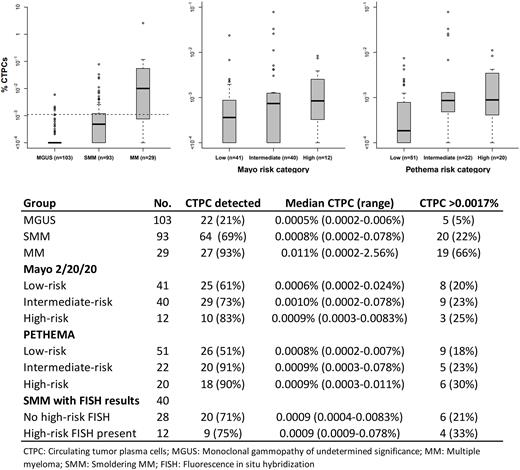Abstract
Background The presence and number of circulating tumor plasma cells (CTPCs) in peripheral blood (PB) as detected by flow cytometry has previously been associated with increased risk of progression from smoldering multiple myeloma (SMM) to multiple myeloma (MM). CTPCs may therefore be a marker for tumor burden and/or tumor aggressiveness in SMM that can, if the correlation to progression can be verified, potentially spare patients from bone marrow biopsies. However, the rate of detectable CTPCs in the overall SMM population is not known and the dynamics of CTPC numbers between diseases stages and risk categories in a screened cohort of individuals with SMM have not been studied.
Aim To investigate the detection and quantification of CTPCs in individuals with SMM diagnosed in the screened population-based Iceland Screens, Treats, or Prevents Multiple Myeloma study (iStopMM), and to associate the findings to known clinical risk models of progression from SMM to MM.
Methods Individuals diagnosed with SMM, monoclonal gammopathy of undetermined significance (MGUS) and MM in the iStopMM study were included. Next-generation flow (NGF) cytometry was used to assess CTPC numbers in PB and the limit of detection (LOD) was set at ≥20 tumor PC. An optimal cutoff value of the percentage of CTPC to discriminate between SMM and MM was found using receiver operating characteristic (ROC) curve analysis of individuals with CTPCs detected. In a subgroup of individuals with SMM, interphase fluorescent in situ hybridization (FISH) analysis was performed. The difference in frequency of CTPC was tested between risk groups according to the PETHEMA and Mayo 2/20/20 models, the groups with, and without high-risk FISH abnormalities and between clinical entities (MGUS, SMM and MM). The Mann-Whitney U test or the Kruskal-Wallis tests were used to assess differences observed between two or more than two groups, respectively.
Results A total of 93 individuals with SMM, 29 with MM, and 103 with MGUS were included. CTPCs were detected in 64 (69%) of individuals with SMM, with a median frequency of 0.0009% (range 0.0002-0.078%), or 0.054 CTPC/μL (range 0.011-3.99 CTPC/μL). The median sensitivity reached for samples with undetectable CTPCs was 2.3x10-6 (range 4.8-1.7x10-6). The detection rate and concentration of CTPCs increased from MGUS to SMM and MM (p<0.001 for both, figure) and from low to higher risk categories according to both risk models (table and figure). The increase in frequency of CTPCs according to risk score was only significant for the PETHEMA model (p<0.001), but not the Mayo 2/20/20 model (p=0.19). However, when low-risk individuals were compared to the intermediate/high risk groups according to the Mayo 2/20/20 model, the difference reached statistical significance (p=0.05). An optimal cutoff of 0.0017% CTPCs for SMM vs. MM was found with a sensitivity of 0.70, specificity of 0.69, and area under the curve 0.76 (figure). In total, 20 (22%) individuals with SMM had CTPC over the cutoff. This proportion increased with higher Mayo 2/20/20 risk categories (20% in low-risk, 23% in intermediate-risk and 25% in high-risk SMM) and PETHEMA risk categories (18% in low-risk, 23% in intermediate-risk and 30% in high-risk SMM). In the 40 individuals with SMM who underwent FISH, 12 (30%) had high-risk FISH abnormalities (del(17p), t(4;14) or t(14;16)) present, and of those 75% had CTPCs detected vs. 71% in those without high-risk FISH abnormalities, no difference in CTPC frequency was found between the groups (p=0.11)
Conclusion CTPCs are a potential marker of tumor burden or tumor aggressiveness in SMM and are present in 69% of the overall population with SMM. Both the detection and numbers of CTPCs increase progressively from MGUS, to SMM, and MM. A similar trend was observed with increasing risk score in SMM, according to two established risk stratification models. These results indicate that NGF of PB to detect CTPCs might have a role in the management of SMM. Future studies with serial monitoring of CTPCs will help to further define the clinical value of CTPCs in relation to the risk of progression, and to define how CTPC monitoring impacts the role of established markers, especially to identify individuals with low risk of progression where bone marrow sampling might be omitted. This would focus clinical care and treatments in SMM and MM to those who benefit the most from them while limiting interventions in those who do not need them.
Disclosures
Onundarson:Fiix prothrombin time.: Patents & Royalties. Hultcrantz:Bristol-Myers Squibb: Membership on an entity's Board of Directors or advisory committees; Curio Science LLC: Consultancy; GSK: Consultancy, Membership on an entity's Board of Directors or advisory committees, Research Funding; Intellisphere LLC: Consultancy; Amgen, Daichii Sankyo, Cosette, GSK: Research Funding. Landgren:Janssen: Honoraria, Other: Independent Data Monitoring Committee (IDMC) member for clinical trials, Research Funding; Riney Foundation: Research Funding; Aptitude Health: Honoraria; MMRF: Honoraria; Leukemia & Lymphoma Society: Research Funding; Rising Tide Foundation: Research Funding; Tow Foundation: Research Funding; NCI/NIH: Research Funding; Theradex: Other: Independent Data Monitoring Committee (IDMC) member for clinical trials; Merck & Co., Inc.: Other: Independent Data Monitoring Committee (IDMC) member for clinical trials; Pfizer Inc: Consultancy; Amgen: Honoraria, Research Funding. Harding:The Binding Site: Current Employment, Membership on an entity's Board of Directors or advisory committees. Durie:Amgen: Consultancy, Honoraria; Takeda: Consultancy, Honoraria; Celgene/BMS: Consultancy, Honoraria; Janssen: Consultancy, Honoraria. Kristinsson:Celgene: Research Funding; Amgen: Research Funding.
Author notes
Asterisk with author names denotes non-ASH members.


This feature is available to Subscribers Only
Sign In or Create an Account Close Modal